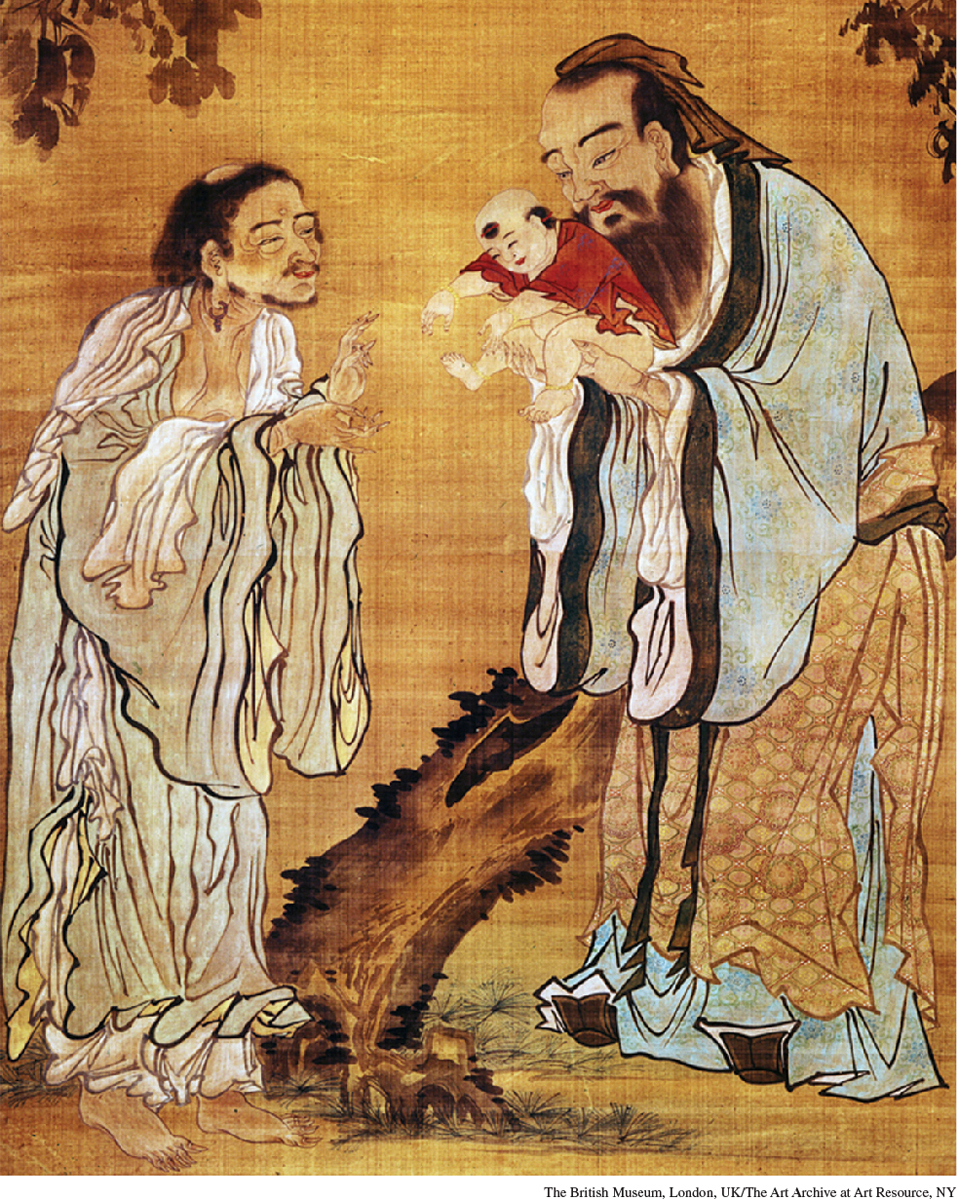Introduction to Chapter 4
CHAPTER 4
Culture and Religion in Eurasia/North Africa
600 B.C.E.–600 C.E.

In September of 2009, Kong Dejun returned to China from her home in Great Britain. The occasion was a birthday celebration for her ancient ancestor Kong Fuzi, or Confucius, born 2,560 years earlier. Together with some 10,000 other people — descendants, scholars, government officials, and foreign representatives — Kong Dejun attended ceremonies at the Confucian Temple in Qufu, the hometown of China’s famous sage. “I was touched to see my ancestor being revered by people from different countries and nations,” she said.1 What made this celebration remarkable was that it took place in a country still ruled by the Communist Party, which had long devoted enormous efforts to discrediting Confucius and his teachings. In the view of communist China’s revolutionary leader, Mao Zedong, Confucianism was associated with class inequality, patriarchy, feudalism, superstition, and all things old and backward. But the country’s ancient teacher and philosopher had apparently outlasted its revolutionary hero, for now the Communist Party claims Confucius as a national treasure and has established over 300 Confucian Institutes to study his writings. He appears in TV shows and movies, even as many anxious parents offer prayers at Confucian temples when their children are taking the national college entrance exams.
Buddhism and Daoism (DOW-
AP® EXAM TIP
Expect questions on the AP® exam about the formation, beliefs, and effects of religions and philosophies that developed in the classical era (ca. 600 B.C.E.–ca. 600 C.E.).
I n the several centuries surrounding 500 B.C.E., something quite remarkable happened all across Eurasia. More or less simultaneously, in China, India, the Middle East, and Greece, there emerged cultural traditions that have spread widely, have persisted in various forms into the twenty-first century, and have shaped the values and outlooks of most people who have inhabited the planet over the past 2,500 years. But we do well to remember that alongside these larger and more extensive cultural systems flourished a multitude of locally embedded and orally transmitted religious traditions. Within the major civilizations, these so-called “little traditions” interacted constantly with the “great traditions,” and in societies that lay beyond the zone of civilization, such as those in Aboriginal Australia, they linked living human beings to the land, to the vegetable and animal worlds, to their ancestors, and to the gods or spirits that inhabited everything. (See, for example, the Aboriginal Dreamtime stories in Working with Evidence, and the discussion of ancient African religious beliefs in “Bantu Africa: Cultural Encounters and Social Variation,” Chapter 6.) Here, however, the spotlight falls on those spiritual or religious traditions that emerged from the civilizations of the second-
In China, it was the time of Confucius and Laozi (low-
These cultural traditions differed greatly. Chinese and Greek thinkers focused more on the affairs of this world and credited human rationality with the power to understand that reality. Indian, Persian, and Jewish intellectuals, by contrast, explored the unseen realm of the Divine and the relationship of God or the gods to human life. All these traditions sought an alternative to an earlier polytheism, in which the activities of various gods and spirits explained what happened in this world. These gods and spirits had generally been seen as similar to human beings, though much more powerful. Through ritual and sacrifice, men and women might placate the gods or persuade them to do human bidding. In contrast, the new cultural traditions of the second-
AP® EXAM TIP
You should know when and where each of the major belief systems developed.
Why did these traditions all emerge at roughly the same time? Here we encounter an enduring issue of historical analysis: What is the relationship between ideas and the circumstances in which they arise? Are ideas generated by particular political, social, and economic conditions? Or are they the product of creative human imagination independent of the material environment? Or do they derive from some combination of the two? In the case of these cultural traditions, many historians have noted the tumultuous social changes that accompanied their emergence. An iron-age technology, available since roughly 1000 B.C.E., made possible more productive economies and more deadly warfare. Growing cities, increased trade, the prominence of merchant classes, the emergence of new states and empires, new contacts among civilizations — all of these disruptions, occurring in already-literate societies, led thinkers to question older outlooks and to come up with new solutions to fundamental questions: What is the purpose of life? How should human society be ordered? What is the relationship between human life in this world and the moral or spiritual realms that lie beyond or within? But precisely why various societies developed their own distinctive answers to these questions remains elusive — a tribute, perhaps, to the unpredictable genius of human imagination.
| A MAP OF TIME | |
|---|---|
| 800–400 B.C.E. | Upanishads composed |
| 9th–6th centuries B.C.E. | Hebrew prophets (Amos, Hosea, Micah, Isaiah) |
| ca. 7th–6th centuries B.C.E. | Life of Zarathustra |
| 600–300 B.C.E. | Emergence of Greek rationalism |
| 6th–5th centuries B.C.E. | Life of Buddha, Confucius, Laozi |
| 586–539 B.C.E. | Jewish exile in Babylon |
| 558–330 B.C.E. | Achaemenid dynasty in Persia; state support for Zoroastrianism |
| 500–221 B.C.E. | Age of warring states in China |
| 469–399 B.C.E. | Life of Socrates |
| 221–206 B.C.E. | Qin dynasty in China |
| Early 1st century C.E. | Life of Jesus |
| 10–65 C.E. | Life of Paul |
| 4th century C.E. | Christianity becomes state religion of Roman Empire, Armenia, Axum |
SEEKING THE MAIN POINT
Fundamentally, religions are basically alike. Does the material of this chapter support or challenge this idea?